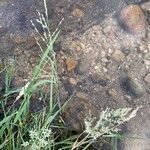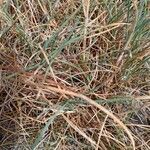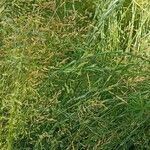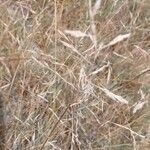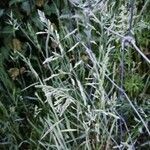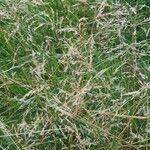Caespitose perennial or annual. Culms erect, sparsely branching intravaginally, 30–60 cm high. Leaves: ligule 0.9–3 mm long; blade involute, 5–11 cm long, 1–2 mm wide. Inflorescence well exserted above flag leaf, 8–20 cm long; lateral branches mostly bare in lower 1/3–1/2, spreading at anthesis, some branches reflexed; primary branches undivided at least 1–2 mm, up to 15–25 mm; maximum total branch length 50–75 mm. Spikelets 3.4–6.4 mm long; bisexual florets 3–7. Lower glume 0.7–1.5 mm long; upper glume 1.2–2 mm long. Callus sparsely pubescent. Lemma 1.5–2.5 mm long, glabrous to sparsely puberulous near base; midvein not extending to the erose margin. Palea 1.8–2.6 mm long; keels scabrous to cilate in lower half. Anthers 0.9–1.1 mm long, creamy white.
Tufted perennial 1–5 dm, decumbent at base; lvs 1–4 mm wide, flat, often becoming involute; ligules mostly under 2 mm; infl ovoid, 6–20 cm, loosely branched, its branches and pedicels scabrous, the lower branches spreading or reflexed, usually bearing spikelets only beyond the middle; spikelets 3–5 mm, 3–7-fld; glumes ovate, the first 0.7–1.8 mm, the second 1.2–2 mm; lemmas elliptic to obovate, obscurely veined, glabrous or short-pilose at base, scabrous on the margins toward the broadly obtuse to truncate tip; first lemma 1.7–2.5 mm; anthers 0.7–1.1 mm; 2n=14, 28, 42. Native of Europe, naturalized along the coast from N.B. to Del., and becoming common inland especially along highways in our range, w. to the Pacific.
Tufted perennial, 250-650 mm high; basal sheaths white. Leaf blade 70-180 x 2-4 mm; ligule an unfringed membrane. Inflorescence a pyramidal to elongate panicle; branches spreading to deflexed; spikelets absent in lower half. Spikelets 4-8 x 1-2 mm, laterally compressed, disarticulating above glumes, awnless; glumes very unequal, shorter than spikelet; lower glume 1-nerved; upper glume 3-nerved. Florets 2-12, bisexual; lemma 1.5-4.0 mm long, entire, back rounded, glabrous to hairy at base, nerves inconspicuous, minutely hairy, margins broadly membranous, apex thinly scarious to hyaline; palea bifid, keels ciliate, margins glabrous; anther 0.6-1.2 mm long. Flowering time Apr., June, July, Oct.
Loosely to densely tufted perennial 250-650 mm high; culms 2-3-noded. Leaf blade 70-180 x 2-4 mm. Inflorescence pyramidal to elongate, more than 15 mm in diameter, open or contracted; lower branches slender, erect and spreading or deflexed, spikelets in upper 2/3 sometimes in the lower 1/2 on some branches; spikelets dense, overlapping for more than 1/2 their own length. Spikelet 4-9 x 1-2 mm; glumes subacute to obtuse; lemma 1.5-4.0 mm long, back rounded, apex broadly obtuse to rounded, margin broadly membranous, apex often minutely hairy, nerves inconspicuous, glabrous to hairy at the base; palea bifid, keels ciliate; anthers 0.6-1.2 mm long.
Perennial, tufted, pale green. Culms erect or geniculate, 20–40(–60) cm tall, ca. 1–2 mm in diam. Ligule 1–2 mm, truncate or toothed; leaf blade flat or conduplicate, 2–10 cm, 1–2 mm wide, abaxial surface scabrid. Panicle open, 5–15 × 5–6 cm; branches 2–6 per node, horizontally spreading or reflexed, lower part naked, scabrid. Spikelets 4–6 mm, florets 3–7; glumes obtuse, lower glume 1–1.5 mm, 1-veined, upper glume 1.5–2 mm, 3-veined; lemmas 1.8–2.2 mm, base pubescent, apex truncate or rounded; palea keels scabrid; anthers 0.5–0.8 mm. Fl. May–Jul. 2n = 28, 42.
Tufted perennial, up to 0.65 m tall. Leaves linear, flat; ligule an unfringed membrane. Inflorescence a pyramidal or elongated panicle, branches spreading, often horizontally or deflexed. Spikelets 4-8 x 1-1.5 mm, congregated on the upper half of panicle branches with lower part free of spikelets, awnless, many-flowered; glumes shorter than spikelet; lower glume 1-nerved, upper 3-nerved; lemma rounded, glabrous or hairs present at base, 5-nerved. Apr., Jun., Jul., and Oct.
A grass. It keeps growing from year to year. It forms tufts. It grows 20-40 cm tall. The stem are 1-2 mm wide. The leaf blade is 2-10 cm long by 1-2 mm wide. The flower is an open panicle.
Perennial to 65 cm. Leaves linear. Spikelets in a pyramidal to elongate panicle more than 15 mm diam., closely overlapping, at least some branches naked in lower half and spreading.
